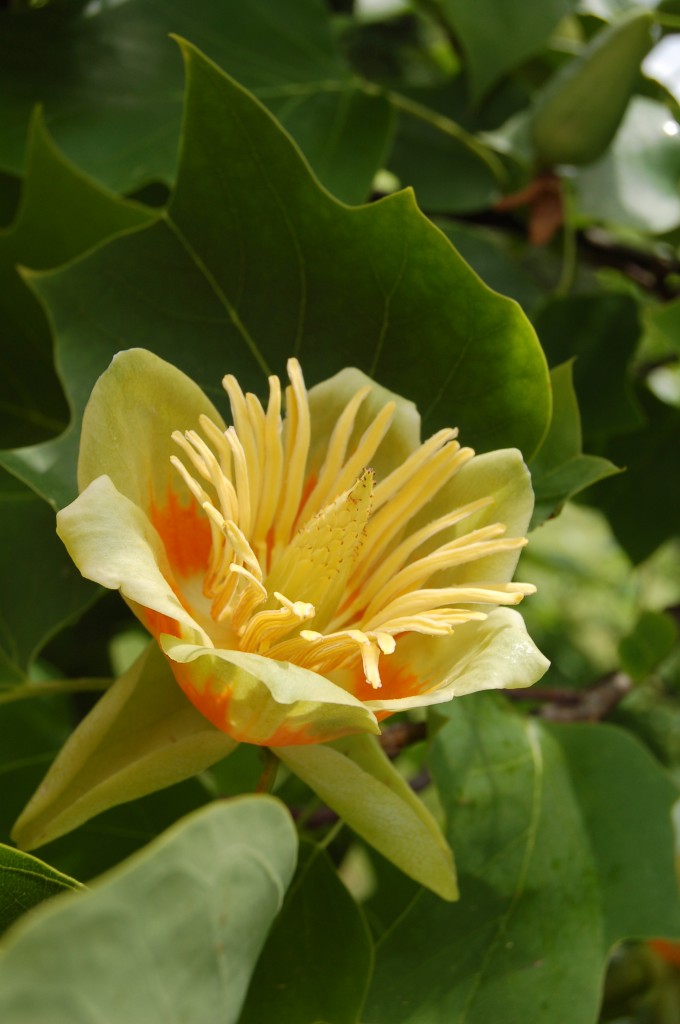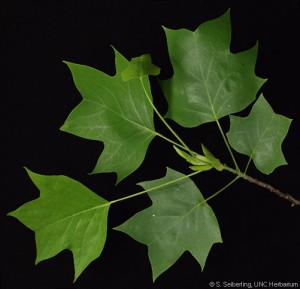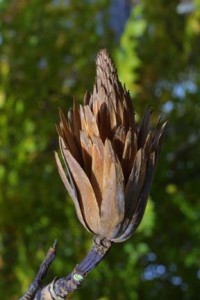Not every edible plant has to be a nutritional powerhouse. Some are “edible” by the barest of means. A good example is the Tulip Tree, Liriodendron tulipifera, said leer-ee-oh-DEN-drawn too-lih-PIFF-er-uh.
What if you read that a native plant was “used to make honey.” What would you think? Probably that the plant was cultivated for bees to make honey. Unfortunately that is not what my reference says. It say the Native Americans made honey from the Tulip Tree. That’s rather doubtful. First people don’t make honey, bees do. And more specifically honey bees are not native to North America. They came with Europeans. It doubtful until perhaps late in the game did Natives cultivate the Tulip Tree for honey. They didn’t have the bees. However, when the bees got here the flying nectar mavens did discover Tulip Trees.
Some references say Tulip Tree roots were used as a flavoring to take the bitterness out of Spruce Beer. I’ve had Spruce Beer and it does need something to make it more palatable. But one expert on Native Americans lists under “sauces and garnishes” that Tulip Trees were used to make honey. As mentioned above that’s not probable but here’s a possible answer that fits nicely with our foraging interests.
For just a short time while the tree is blossoming there is a small amount of very sweet nectar in each blossom. It is heavy and honey-flavored. You can drink it directly from the blossom. The expert was relying on old reports that probably didn’t describe how the natives used the tree. They weren’t collecting honey, they were collecting nectar. The tree was also called the Sap Poplar, perhaps because its sap is consumable. I don’t know and have not found any reference to said but it wouldn’t surprise me. As a source of nectar the tree also attracts hummingbirds, squirrels and is a host plant for tiger and spicebush swallowtail butterflies.
The genus name is bastardized Greek via Dead Latin. Liriodendron. Lirio is a Greek derivative for Lily, dendron Greek for tree, Lily Tree. Tulip is the English version of a Turkish word Tuliband. That is bastardized Persian for dulband which means turban. “Ifera” is Latin and means producing. Liriodendron tulipifera thus is “Lily Tree Producing Tulips.” The tree is also called Yellow Poplar, Tulip Poplar, White Poplar, and Whitewood.
Related to the Magnolias, the Tulip Tree can be found in eastern North America plus Texas. To see a good video on the Tulip Tree by my foraging colleague Blanche Derby, click here.
Green Deane’s Itemized Plant Profile: Tulip Tree
IDENTIFICATION: Liriodendron tulipifera, 100-foot tree, sometimes to 150 feet. Leaves alternating, simple, palmately veined, orbicular (circular and flat) 4-lobes, no teeth, 4 to 8 inches long, notched to flat top. Somewhat shaped like a tulip, light green to green. Blossom, monoecious; perfect, showy, resembling a large tulip, but high in the tree, 2.5 inches long, with yellow-green petals and an orange corolla. Fruit is cone-like with many samaras (2 inches long) falling off at maturity; each samara is 1-winged, 1.5 inches long, and curved upwards resembling the front keel of a boat, maturing August to October and falling through late fall and winter. The base whorls of samaras persist into following spring and resemble wooden flowers high in the tree.
TIME OF YEAR: Flowers appear in late spring to early summer.
ENVIRONMENT: Grows in a wide variety of soil. The effects of temperature and moisture extremes are mitigated some by the lay of the land. At the northern end of its range, yellow-poplar is usually found in valleys and stream bottoms at elevations below 1,000 feet. In southern Appalachia, it can grow on a variety of sites, including stream bottoms, coves, and moist slopes up to an elevation of about 4,500 feet. Toward the southern limit of the range, where high temperatures and soil moisture probably become limiting, the species is usually confined to moist, well-drained, stream bottoms. Optimum development occurs where rainfall is well-distributed over a long growing season.
METHOD OF PREPARATION: The blossom can be tipped and the nectar sipped out.




